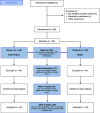What are the effects of dry cupping therapy combined with the McKenzie method on clinical outcomes in chronic low back pain? A protocol for a randomized, sham-controlled trial
- PMID: 40604805
- PMCID: PMC12220493
- DOI: 10.1186/s12906-025-04940-9
What are the effects of dry cupping therapy combined with the McKenzie method on clinical outcomes in chronic low back pain? A protocol for a randomized, sham-controlled trial
Abstract
Background: Although exercise is a first-line approach to treating chronic low back pain (CLBP) in clinical practice, passive techniques such as dry cupping therapy are considered complementary to this condition. However, knowledge about the effects of combining dry cupping therapy with active exercises in people with non-specific CLBP is shallow.
Objective: To evaluate the effects of dry cupping therapy with the McKenzie method (MDT) on disability and functional outcomes in people with non-specific CLBP.
Methods: Eighty-eight people with non-specific CLBP aging 18 to 59 years will be recruited and evaluated for inclusion and exclusion criteria. Participants will be randomized into intervention (MDT and dry cupping therapy) or sham group (MDT and sham dry cupping therapy). Dry cupping therapy will be applied bilaterally to the vertebrae (L1 to L5). Interventions will be performed twice a week for eight weeks, and participants will be assessed before treatment (T0), immediately after the first intervention (T1), and at four (T4) and eight weeks of intervention (T8). Primary outcomes will be disability (Oswestry Disability Index). Secondary outcomes will be functionality (Timed Up and Go Test), pain (Numeric Pain Rating Scale), trunk range of motion (Toe-touch Test) and participant expectation and perception (Global Perceived Effect Scale).
Discussion: Despite recent research, there is no consensus in the literature regarding the effectiveness of dry cupping therapy in the treatment of people with non-specific CLBP. Also, no study with high methodological rigor has evaluated the combination of dry cupping therapy with active exercise in this population and whether this combination potentiates any clinical effect. Thus, this protocol may guide further research to support the prescription of exercise combined with dry cupping therapy in people with non-specific CLBP. The results of the study will be disseminated to participants through social networks and will be submitted to a peer-reviewed journal and scientific meetings.
Trial registrations: ClinicalTrials.gov, October, 2023 (report number: NCT05459376).
Keywords: Chronic pain; Complementary therapies; Exercise therapy.
© 2025. The Author(s).
Conflict of interest statement
Declarations. Ethics approval and consent to participate: This study was approved by the ethics committee of Onofre Lopes University Hospital of the Federal University of Rio Grande do Norte (report number: 5.345.554). An informed consent form will be explained and signed by each individual. Procedures will be conducted according to the Declaration of Helsinki. Respect for individuals will be ensured, and autonomy will be maintained. Individuals will be informed about the aims of the study, risks and benefits, and the right to withdraw from the study at any time without explanations. Consent for publication: Informed consent was obtained from all subjects and/or their legal guardians for the publication of identifying information/images in an open-access online publication. Competing interests: Mariana Arias Avila and André Pontes-Silva are BMC Musculoskeletal Disorders’ Editors and Reviewers. All other authors do not have any Competing interests.
References
-
- James SL, Abate D, Abate KH, et al. Global, regional, and national incidence, prevalence, and years lived with disability for 354 diseases and injuries for 195 countries and territories, 1990–2017: a systematic analysis for the Global Burden of Disease Study 2017. Lancet. 2018;392:1789–858. - PMC - PubMed
-
- Hartvigsen J, Hancock MJ, Kongsted A, et al. What low back pain is and why we need to pay attention. The Lancet. 2018;391:2356–67. - PubMed
-
- Qaseem A, Wilt TJ, McLean RM, et al. Noninvasive treatments for acute, subacute, and chronic low back pain: A clinical practice guideline from the American College of Physicians. Ann Intern Med. 2017;166:514–30. - PubMed
Publication types
MeSH terms
Associated data
LinkOut - more resources
Full Text Sources
Medical



